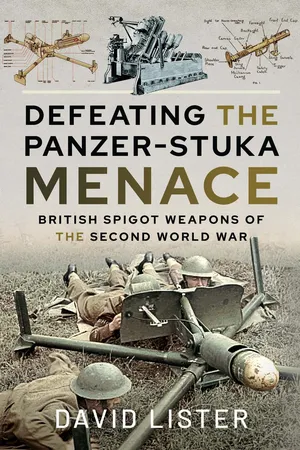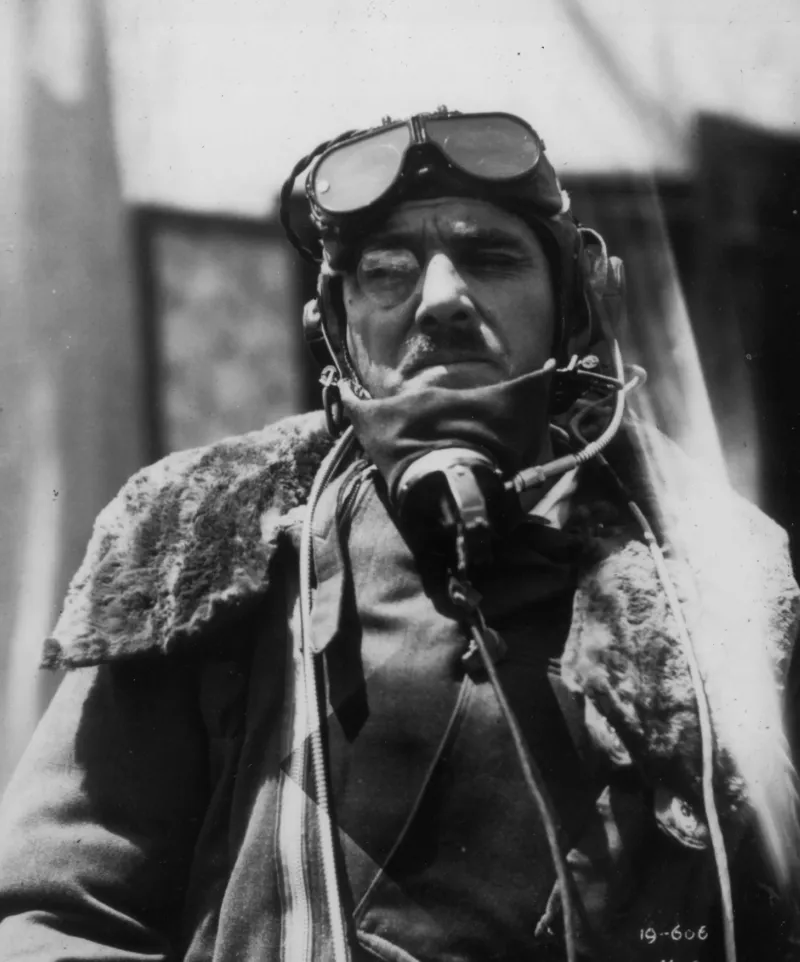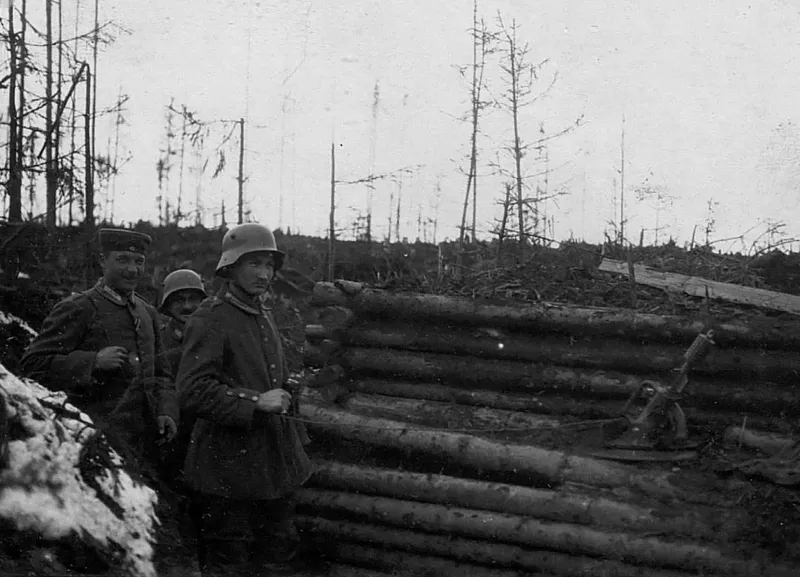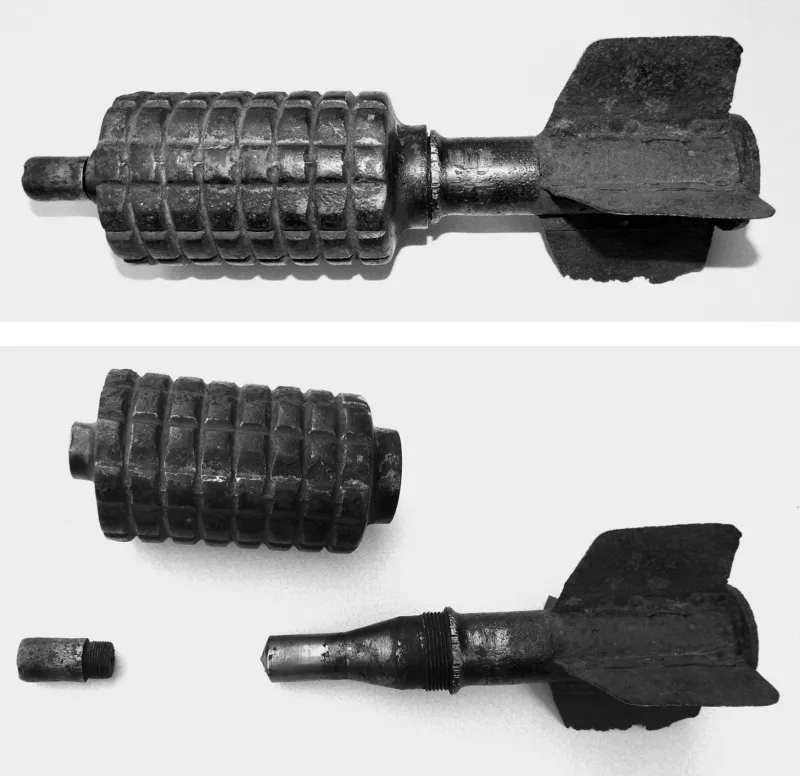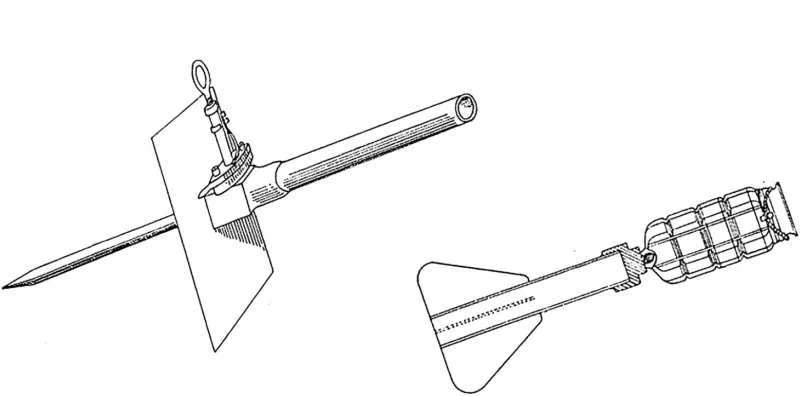![]()
PART ONE
OF MEN AND SPIGOTS
![]()
Chapter One
Products of Empire
Before we can talk about spigot weapons, and their use in the Second World War, we need to cover some background subjects. The first, and most important of all, are the people involved. By and far the most significant of these is Latham Valentine Stewart Blacker, OBE. He was a prolific inventor, who produced ninety-two designs for assorted weapons between 1935 and 1943. He was responsible for the introduction of the spigot mortar into British service during the Second World War, and thus all the subsequent events throughout the conflict.
Born at the height of the Empire in 1887, Blacker had a close interest in artillery even at a young age. His father, Major Latham Blacker, commanded a pair of guns at Gibraltar. Later, on HMS Himalaya, when moving back to the UK as a pre-schooler, he paid special attention to the Armstrong guns the ship carried for protection. When at boarding school, he entertained himself with ballistics, and along with a small group of boys managed to construct an improvised mortar that fired a croquet ball propelled by charges of black powder. The first and only target of this weapon was the headmaster’s green-house, on which they scored a direct hit at a range of some 300yd. From boarding school he went to Sandhurst, and eventually in 1907 entered the Indian Army, and began serving on the lawless North-West Frontier, where he started learning about the local culture. Every four years British members of the Indian Army were given a prolonged period of leave allowing them to return home. Blacker’s first leave fell in 1911, and he used the opportunity to return to the UK and begin to learn how to fly. The cost of his flying lessons was some ₤75, a rather princely sum. However, Blacker was gifted this amount by Ramji Lal. Blacker succeeded in qualifying as a pilot, being awarded certificate number 121 from the Royal Aero Club.
Later in 1911 Blacker returned to India, and the Royal Corps of Guides and began further adventures in the North-West Frontier. It was on one of his long patrols in the area in August 1914 that Blacker heard of the outbreak of the First World War. He came back to the UK and was immediately posted to the Royal Flying Corps (RFC). His first task was to try and tackle Zeppelins, with assorted early aircraft armed with eccentric weapons of war that every inventor in the UK put forth, claiming his contraption as the answer to the Zeppelin menace. One such device was named the Fiery Grapnel and consisted of a TNT-filled tube with spikes, and the most absurd means of detonation ever devised. The tiny planes of the RFC were to hook the device into the fabric of the Zeppelin and await the explosion that would destroy the target. As usual, the inventor obviously failed to spot the main problem, that the underpowered aircraft would find it utterly impossible to reach the Zeppelin’s cruising altitude. In the first months of 1915 Blacker was posted to France, where he had several aircraft shot out from under him. After the Battle of Neuve Chapelle, where the Indian Army sustained heavy casualties, Blacker had a crisis of conscience, and thus decided to leave the RFC and re-join the infantry in the trenches. He reached the front in the wake of the first German gas attacks, and with no defence against such a weapon, he led the battered remains of Indian infantry in counter-attacks. During this period he was wounded by artillery and spent some six months out of action.
Stewart Blacker in his flying gear, possibly ready for his flight over Everest, 1933.
It is at this time, at the end of 1915, when the story of the spigot mortar really begins. On the German side of the line a Hungarian priest known only as Father Vécer, or so the story goes, designed a spigot mortar. When the first weapons reached the front line, the troops initially called them the Priester-werfer. It seems there was a previous design of spigot mortar, firing a similar round of ammunition, however the Priesterwerfer is the most famous. It was later standardized as the Granatenwerfer 16. It was a frame contraption with a spigot mounted on it. The entire frame could be traversed to provide an arc of fire, and the spigot could be raised or lowered to alter the range. It fired a projectile of about 5.5lb out to a range of roughly 330yd.
The British answer was the much cruder Hay Pocket Howitzer. Designed and proposed by Lieutenant Commander J. Hay of the Royal Navy, this was essentially a large spike and baseplate that was driven into a bank pointing in the direction you wished to fire. Earth could be banked under the plate to slightly alter the angle. Range was achieved by different sized charges. Each was rammed down the fixed barrel that stuck out of the baseplate. This barrel was the spigot over which the projectile was fitted. A pull ring, to which a lanyard was attached, was provided. Pulling on this fired the charge and sent the grenade, which weighed just over 1lb, on its way. A maximum range of 450yd was achieved with 5 grains of gun cotton and 35 of ballistite, where-upon the grenade left a distinctly unimpressive 30in crater. This contraption was tested by the Ordnance Committee on 25 November 1915. Later, after the Second World War, Millis Jefferis, whom we shall come to in a moment, stated that Blacker first proposed a spigot weapon in 1915, however there appears to be no record of this proposal, and Blacker himself does not make mention of it.
A Granatenwerfer 16 set up, ready to fire, in a trench, belonging to the 6th Company of the 3rd Grenadier Regiment. One wonders how close to the front this position is as the Germans are exposing rather more body than seems prudent. (Bild)
A Granatenwerfer 16 projectile, both complete and disassembled. The bomb was propelled by a blank 7.92 × 57mm Mauser bullet, and the tail tube was formed around that, hence the step-down. The tail tube calibre was 1in, which is a rather curious choice considering both Germany and Austria were metric countries.
Sketch of the Hay Pocket Howitzer and its bomb.
Blacker, when recovered, returned to the RFC. By a stroke of luck, his spell in the trenches meant that he had missed the Fokker Scourge. Blacker was a doer, and would instantly and ferociously attack any mechanical problem. In this case, interrupter gear had been designed but used a mechanical linkage. Blacker felt that he could improve on the system in a way that would not be affected by wear and temperature changes like the existing device. With the help of a Romanian engineer, they developed a hydraulic system which Blacker states was used for decades. During related trials on a machine-gun mounting, Blacker managed to shoot himself down, breaking his neck and ending his flying career.
At this point he returned to India and was involved, once again, in the ‘Great Game’ on the North-West Frontier and several campaigns in the Russian Civil War. In 1922 he was promoted to staff college at Quetta. From there he returned to UK, although he experienced quite a few adventures in Eastern Europe.
In 1932 Blacker’s inventiveness turned to peacetime pursuits after he designed a new and improved aircraft machine gun. He began to work on a project to fly over Everest, and more importantly to film the passage. Both crew and cameras needed to be heated, and special devices were designed and constructed by the team to this end, the project taking place in 1933. Blacker himself was on one of the planes as an observer.
Following his return to the UK, until his death in 1964, Blacker began to invent and design weapons. His fertile imagination created a great mass of ordnance for reigning destruction upon the enemies of the king. The scope of this can be seen from the designations of his inventions. At least for a time, he took to numbering each weapon he designed sequentially. In 1935 he produced a weapon he called the ‘Arbalest’, which carried the title of Gun Number 8. In 1943 there are records indicating he had reached number 100.
Blacker beat several other designers to ideas, although he failed to patent these designs, and so lost his protections. In 1947 he designed a small, light-weight, bull-pup carbine that fired 9.5mm rockets, beating Robert Mainhardt and Art Biehl of Gyrojet fame to the idea by thirteen years. In 1937 Blacker designed a new type of magazine, although what gun it was intended for is hard to work out. It consisted of two drums feeding into a single-stack magazine. This was fifty years before the Beta Company brought out their C-mag. Blacker’s design is all but identical to the modern equivalent.
At the time of the Dunkirk Evacuation, Blacker had been serving as a colonel in a Territorial Army artillery unit. He was hurriedly ordered to report to Woolwich barracks. Once there he found himself without a job as the original scheme the army had in mind for him was altered by the fast-moving situation in France. As luck would have it, he then bumped into General Hastings Lionel Ismay, an acquaintance from his time at Quetta. General Ismay sent him to the Military Intelligence Research Section C (MIRc), a research and development department of the army, which, in Blacker’s own words, ‘improvised infernal machines’, and it seemed the ideal place for someone with Blacker’s talents.
While an undoubted genius at weapon design, Blacker had a strong dislike of bureaucracy and was very much a man of action. This meant he often suffered reverses in the corridors of government. He wrote a letter on 3 September 1941 that perfectly demonstrated his prickly nature. Henry Mond, the 2nd Baron Melchett, often referred to as Lord Melchett, was in control of Imperial Chemical Industries (ICI), the producer of the Bombard. As we shall see, there were production difficulties which meant that just 15 bombards had been produced, against a forecast number of 3,600. Blacker wrote to Professor Frederick Lindemann, Churchill’s scientific advisor, about the situation, protesting loudly in just five terse sentences. He closed off the letter with, ‘He has his choice between murder and suicide.’ Equally, Blacker kept a file he labelled ‘Official Obstruction’ where every rejection or similar reproach was stored like a book of grudges.
Having such a loose cannon rolling about in Whitehall was an unappealing prospect, and in about May 1941 Blacker was politely retired. He officially retired in October 1942 leaving the army for good. However, at some point between these two dates, Blacker set up his own company, Blacker Developments Ltd. He employed a small team of draughtsmen, who would turn his sketches, plans and ideas into complete and finalized drawings. It appears that Blacker Developments Ltd ceased trading shortly after the war, although exact dates are difficult to find. From then on, until his death in 1964, Blacker spent his time tinkering and experimenting. This was mainly with rocketry, although he did expend quite some effort on a new type of recoilless rifle. This was designed to fire a counterweight at an angle, up and to the rear of the projector. The idea seems to have been to remove both the massive firing signature and the danger zone that normally accompanies recoilless rifles.
Shortly after his death, Blacker’s wife, Lady Doris Peel, contacted the local Royal Engineers bomb disposal team and asked them to attend and make her husband’s laboratories safe. It took the bomb-disposal team an entire day to remove all the explosives, which ranged from simple black powder to modern shaped charges. The following day the engineers began to carry out controlled explosions on the recovered explosives, and this alone took several hours. There is a tale that many years later after the Blackers’ home had been sold, renovation work was being carried out in the basement. During the work, the builders knocked through a false wall and found themselves confronted with Blacker’s emergency supplies, which he had obviously secreted away against future need, perhaps if the Germans, or later the Soviets, had invaded. This store of explosives had been mouldering in the basement uncared for and was more than enough to replace the fine country house with a very large crater. This collection was also made safe by bomb-disposal personnel.
The other name often associated with British Second World War spigot weapons is Millis Rowland Jefferis. At first glance, there is a strong bio-graphical resemblance between the two men. Jefferis was just four years younger than Blacker. However, during most of the First World War Jefferis was completing his studies at the Royal Military Academy in Woolwich, and only saw action with the Royal Engineers in the dying days of the war. From there he travelled to India and served on the North-West Frontier, where he took part in the Waziristan Campaign. For his actions in this operation, he was awarded the Military Cross. After more schooling at Cambridge, he returned to India in 1925, where he remained until 1936, and again like Blacker became fluent in Pashto. During his entire time in India, he was part of the Royal Engineers, and one of his principal roles was bridge building. From there, his interest in bridges morphed into an interest in explosives and how to blow up bridges and structures.
While in Britain Jefferis remained part of the army and when the Second World War broke out he was running MIRc. It suddenly became clear during the Norwegian Campaign that there were several bridges that needed demolishing. The army cast about for someone to do the job and settled on Jefferis. While there he was ordered forward to help with demolitions on a railway bridge, which the now Allied Norwegians refused to allow to be blown up. Now in the front lines, the unit Jefferis was with was surrounded and overrun. Jefferis linked up with three soldiers, whom he led to safety through the German lines. On his way, he blew up a pair of bridges to hinder the German advance. For his actions, he was mentioned in dispatches. From there it seems he returned to MIRc.
Jefferis, like Blacker, hated bureaucracy and officialdom, referring to them as ‘abominable no-men of Whitehall’. However, instead of giving both men a common enemy, it seemed they disliked each other equally. Documents do not mention any interaction between the two, even minutes of meetings with both men, it is an utter void, almost as if both men tolerated the other’s presence by ignoring them, lest they were impolite. Part of the problem seems to have come from their differing attitude to design. Jefferis was highly educated, and a capable mathematician. Blacker, on the other hand, came from the school of ‘let’s build it and see what breaks!’ Jefferis saw the lack of learning in Blacker as a huge flaw, and it is possible that Blacker saw Jefferis as just another bureaucrat in uniform. Blacker does, in his autobiography, accuse Jefferis of stealing the idea for the Projector, Infantry, Anti-Tank (PIAT). Matters were possibly not improved by Winston Churchill repeatedly calling for the PIAT to be renamed the ‘Jefferis Gun’, citing the presence of Smith Guns, Hawkins Mines and even Blacker Bombards. It was not until the War Office sat down and explained the facts in detail, and pointed out that it was not current policy to use officers’ names for weapons, having hurriedly renamed all the weapons listed to much more military sounding terms, that Churchill ceased his requests.
After the Second World War Jefferis remained in uniform rising through the ranks until he retired in 1953 as an honorary major general. Jefferis was to die just seven months before Blacker in September 1963. Unlike Blacker, Jefferis never wrote an autobiography, and, indeed, he seems to have been far more discreet about his life and as a consequence less information about him is readily available.
With both inventors at loggerheads with each other and the surrounding Civil Service, it is a miracle that any of the projects that emerged from MIRc ever came close enough to a German to blow him up. Much to the chagrin of the Germans, and the good fortune of Britain, MIRc had such a miracle in the form of Robert Stuart Macrae in the role of administrator. Macrae also took part in the weapons design process. It is likely that Macrae’s input combined with Churchill’s direct interest and support meant that the ‘infernal machines’ from MIRc caused such widespread mayhem for the Germans.
If it is difficult to find information on Jefferis, Macrae is all but invisible. Macrae had started his working life as an engineer, but by the late 1930s was the editor of Armchair Science magazine and an unnamed gardening magazine.
He was recruited to MIRc when Jefferis was looking for information on strong magnets for the limpet mine project. He also worked on ‘poulticing explosives’, which as we shall see was quite an important concept. Macrae remained in the army until 1955 when he retired with the rank of honorary colonel.
Blacker’s and Jefferis’ views on bureaucrats were, probably, largely down to the misguided belief that it was simple to do something. Throughout 1940 Blacker was often heard to say that if the War Office had listened to him then the British Army would have been equipped with a weapon that would have enabl...
